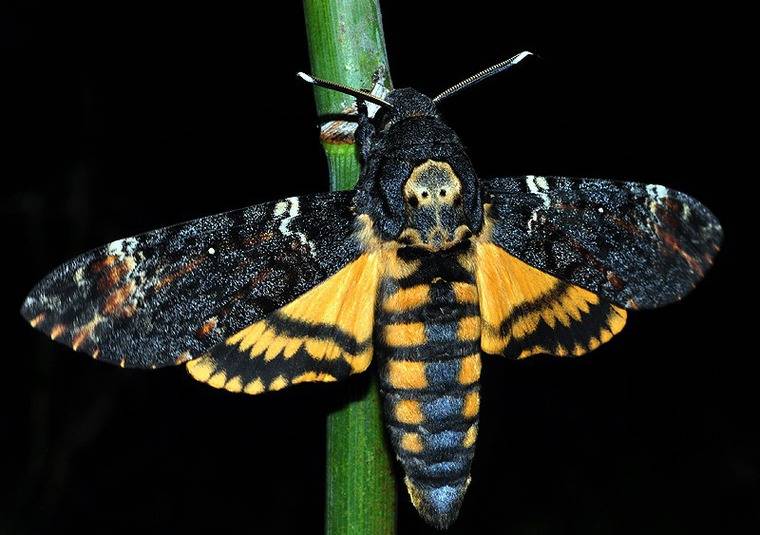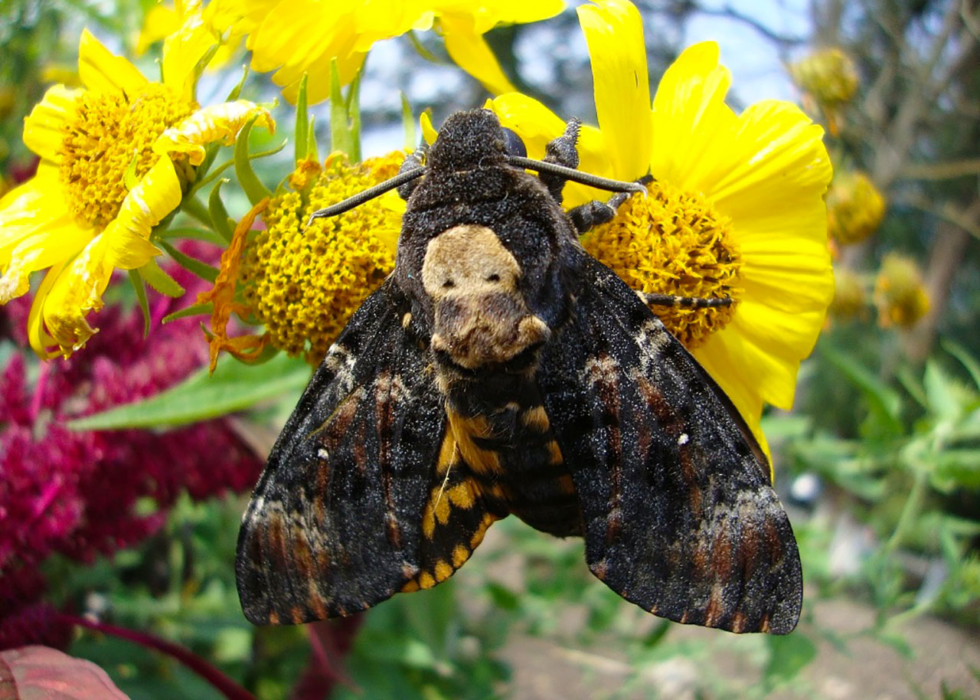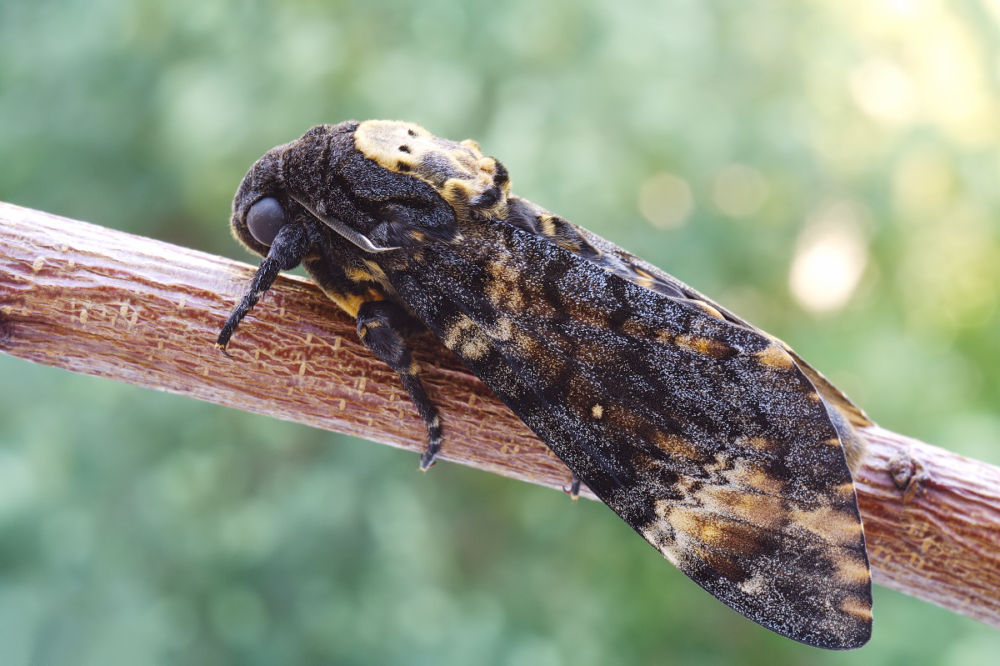The dead-head butterfly (Latin Acherontia atropos) is the largest of the individuals that can be found in Russia and Europe. It differs from others in a unique pattern on the back that resembles a skull. This has led to the emergence of numerous legends. The insect leads a nocturnal lifestyle. It can be lured by the light of a candle or a flashlight.
Material Content:
Description of the Butterfly "Dead Head"
The insect described represents the Brazhniki family. The length of the anterior wing is 4-5 cm, sometimes 7 cm. The wingspan in males is 9-11.5 cm, in women - 10-13 cm.
 Males weigh from 2 to 6 g, females 3-8 g. The color of the head is almost black or black-brown, the back is bluish-brown or black-brown, on which there is an ocher-yellow pattern. It looks like a skull with pronounced eye sockets. The breast below and the edge of the abdomen are painted in the same color. Abdomen up to 6 cm long, up to 2 cm thick.
Males weigh from 2 to 6 g, females 3-8 g. The color of the head is almost black or black-brown, the back is bluish-brown or black-brown, on which there is an ocher-yellow pattern. It looks like a skull with pronounced eye sockets. The breast below and the edge of the abdomen are painted in the same color. Abdomen up to 6 cm long, up to 2 cm thick.
Eyes without eyelashes or the third century do not close during sleep, their shape is round. Proboscis 1-1.4 cm, short, but thick.
Insect habitat
The dead head butterfly lives in the subtropics and tropics: in Madagascar, in Africa, in the countries of the Middle East, it is found on the European continent.
In Russia, she was seen in the Caucasus, in the Central and Southern regions of the European part. There are even unconfirmed reports from the Tyumen region.
Lifestyle & Nutrition
Butterfly refers to migratory insects that travel north each year. Under favorable weather conditions, they reach Iceland. Brazhnik has unique flying abilities: it speeds up to 50 km / h.High buzz takes off and emits a low buzz, which is caused by the fact that the insect makes 52 flaps of the wings in 1 second.
 It is found in Africa at any time of the year. In Europe, the first migratory hawks are noticed in May or even earlier, when winter-surviving specimens emerge from the pupae.
It is found in Africa at any time of the year. In Europe, the first migratory hawks are noticed in May or even earlier, when winter-surviving specimens emerge from the pupae.
Individuals feed on fruit juice and honey, rather than nectar. They make their way into the hive, pierce the honeycomb with a proboscis and suck out honey, 5-15 g at a time.
It was once believed that since the hawthorn is able to make sounds similar to the buzz of a queen bee, working bees do not touch it. In fact - it soothes bees by releasing substances that mask the smell. This is called chemical mimicry. The bee stings are not afraid, it is protected by a dense hairline.
Shrill squeals in fright, in addition, it makes sounds by the friction of the jaws.
 The caterpillars of this butterfly can be called omnivores. Of course, they have food preferences, but they eat everything. They love potatoes and other plant components:
The caterpillars of this butterfly can be called omnivores. Of course, they have food preferences, but they eat everything. They love potatoes and other plant components:
- Tomatoes
- eggplant;
- physalis;
- nightshade;
- dope;
- belladonna;
- tobacco.
Plants or leaves of the following species can eat:
- elderberries;
- viburnum;
- dill;
- carrots;
- cabbage;
- honeysuckle;
- ash;
- lilacs and others.
Population and breeding
Butterfly is often found in a single copy. In search of a partner, pheromones produced by the glands of the female help. Mating lasts several hours.
Then the female lays eggs on the lower side of the foliage of plants edible for her larvae. Eggs are bluish or pale green, have an oval shape. Size 1.5x1.2 mm.
Caterpillars of the butterfly dead head large, up to 12 mm. They have five pairs of legs. Before adulthood, they have to go through several stages of development. The color of the caterpillars is usually lemon yellow, yellow-blue, green, and brown are also found.
 An adult caterpillar lives underground in a hole. Selected to the surface, only to eat. This period lasts almost 2 months. After pupation occurs.
An adult caterpillar lives underground in a hole. Selected to the surface, only to eat. This period lasts almost 2 months. After pupation occurs.
Pupa is shiny and smooth. Its length is 50-75 mm, and it weighs 7-12 g. After pupation, the cocoon has a yellow or cream color, after 12 hours it changes, becoming red-brown. It is located in the ground, at a depth of 15-40 cm. This stage of development takes about a month.
A pupa hibernates in the soil, but the cocoon does not. In the spring, she turns into a beautiful butterfly and goes in search of a partner.
Life expectancy of the "Dead Head"
Hogwarts live 3-4 months. Interestingly, the second generation females are sterile. Only new migrants from Africa can replenish the population.
Legends and signs about an unusual butterfly
The special coloring of the insect had a strong psychological effect on people. Superstitions and signs arose that terrified the unenlightened inhabitants.
At the time of the Inquisition, the hawk was considered a peddler of infection and an accomplice in the emergence of epidemics. In addition, it was believed that warlocks and diviners used these butterflies in black magic.
Squeak of an insect was considered a way of communication of sorcerers with dead people in the afterlife.
The Greeks were horrified to meet this butterfly. The reason for this is the awesome name.
In Russia, it was considered a messenger of the imminent death of one of the relatives, so the individual had to be killed at a meeting.
Flakes of butterfly wings were also considered harmful, which, according to legend, could blind.
After "meeting" with a dead head, Edgar Poe wrote a fantastic story "Sphinx", turning it into a terrible monster.
 In the sensational feature film “Silence of the Lambs”, the maniac thrusts into the larynx of his victims the hawthorn pupae.
In the sensational feature film “Silence of the Lambs”, the maniac thrusts into the larynx of his victims the hawthorn pupae.
In 1889, the artist Van Gogh created the canvas, which he called "Brazhnik dead head." But he was mistaken in depicting a completely different insect, which upon closer inspection turned out to be a pear-eyed peacock-eye. Workers in the Amsterdam Museum gave the painting a new name, "Imperial Butterfly."
Ole Bornedal and Sam Raimi, director and producer of the thriller “Curse Box” used these butterflies during the filming.
Poets of the Fall - a rock band from Finland, placed on the cover of its 8 album photos of this particular hawk.
People’s fear has led to a sharp decrease in the number of this type of butterfly. They have become a rarity and are listed in the Red Book. But in fact, this is a harmless nocturnal insect, just with an unusual coloring. A yellow skull is painted on the back of the butterfly, which has generated many superstitions.












